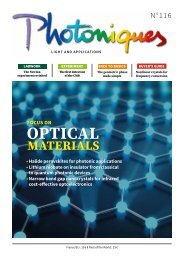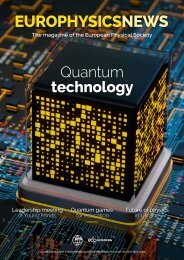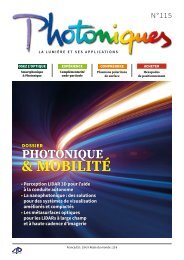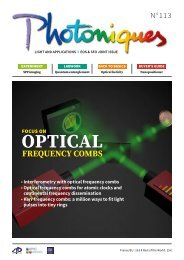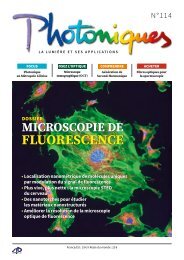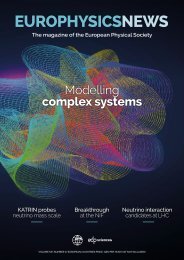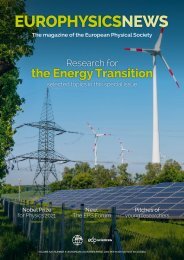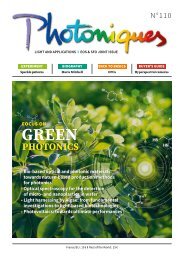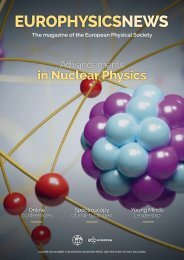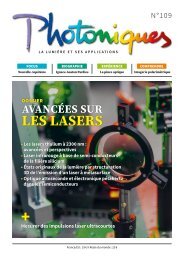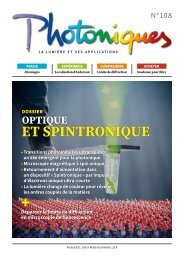EPN 53-3
Create successful ePaper yourself
Turn your PDF publications into a flip-book with our unique Google optimized e-Paper software.
[Column]<br />
The European X-ray Free Electron Laser:<br />
a tool for fundamental research<br />
and a wide range of applications<br />
DOI: https://doi.org/10.1051/epn/2022301<br />
X-ray free-electron lasers (XFELs) are the first<br />
light sources that are able to routinely generate<br />
coherent, ultra-brilliant, tunable laser pulses<br />
in the X-ray regime. The European XFEL (www.xfel.eu), is<br />
a world-leading large scale research facility, member of<br />
EIROforum (www.eiroforum.org), an intergovernamental<br />
association of eight of the leading European large-scale<br />
infrastructures. Thanks to a 1.7 km long, 17.5 GeV linear<br />
electron accelerator based on superconducting resonant<br />
cavities and the Self Amplified Spontaneous Emission<br />
(SASE) process taking place in very long undulator magnet<br />
arrays, high repetition rate ultrashort X-ray<br />
flashes with a brilliance that is a billion times<br />
higher than that of the best conventional<br />
synchrotron X-ray radiation sources are<br />
produced. The European XFEL is opening up<br />
areas of research from physics to structural<br />
biology that were previously inaccessible.<br />
Using the X-ray flashes of the European<br />
XFEL since the start of its operation in mid-<br />
2017, scientists from all over the world are<br />
able to map the atomic details of viruses, decipher the<br />
molecular composition of cells, take three-dimensional<br />
images of the nanoworld, film chemical reactions on the<br />
femtosecond time scale and study processes such as those<br />
occurring deep inside planets and in extreme conditions<br />
of temperature, pressure and applied magnetic field.<br />
The European XFEL is becoming a very efficient<br />
decoder, obtaining in a much shorter time and with<br />
reduced effort many structures for molecules such as<br />
membrane proteins, from which crystals larger than a<br />
micrometer in size are hard to obtain. This will advance<br />
progress in our understanding of pathogens and the<br />
development of pharmaceutical remedies. In addition,<br />
biomolecules modify their structure while performing<br />
their respective tasks. It would be extremely illuminating<br />
to follow these modifications and see the motion of the<br />
moving parts in a movie. To make a film of a moving<br />
object, it is necessary to take many snapshots. Faster<br />
movement requires a shorter exposure time and a<br />
greater number of snapshots to avoid blurring the<br />
pictures. This is where the ultrashort duration of the FEL<br />
pulses will ensure sharp, non-blurred pictures of very<br />
fast processes. During the Covid-19 pandemic, XFEL was<br />
used to gain insights into protein shape and function at<br />
the micro- and nanoscale (SAXS curve). The results from<br />
this experiment could improve our understanding of the<br />
immune response to coronavirus and help to develop<br />
medical strategies to overcome COVID-19.<br />
The European XFEL provides an opportunity to<br />
educate a new generation of scientists to address the<br />
frontiers of research in an open environment, promoting<br />
the European dimension of knowledge and<br />
its international mobility. The European<br />
XFEL is located in the metropolitan area of<br />
Hamburg, Germany, and has a long-standing<br />
collaboration agreement with DESY for the<br />
accelerator operation. It is organized as a<br />
non-profit company with limited liability<br />
under German private law (GmbH) that is<br />
publicly funded (total construction budget:<br />
1.54 B€; operation budget for 2022: 141 M€)<br />
through its international shareholders from 12 European<br />
countries. The shareholders’ assembly, the so-called<br />
Council, is the supreme organ of the European XFEL<br />
GmbH, which decides on all important issues of the<br />
company (like the annual financial statement and the<br />
annual operation budget) and important personnel<br />
matters as well as the further development of the facility.<br />
The Council meets at least three times a year and is led<br />
by a Chair and a Vice-Chair, who are elected from the<br />
Council delegations for a total of up to two terms, not<br />
exceeding two years each, and who, upon election, leave<br />
their delegations and become supra partes.<br />
We note, that Federico Boscherini (in the photo)<br />
Professor of Physics at the Physics and Astronomy<br />
Department of the University of Bologna, has been elected<br />
as the new Chair of the XFEL Council. The appointment<br />
starts from July 2022 for a first two year period. n<br />
l Eugenio Scapparone,<br />
INFN Bologna Section director<br />
14<br />
<strong>EPN</strong> <strong>53</strong>/3



